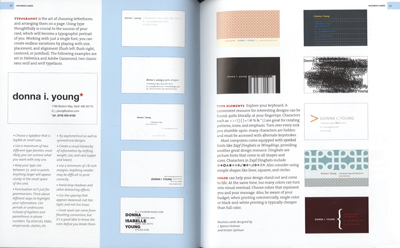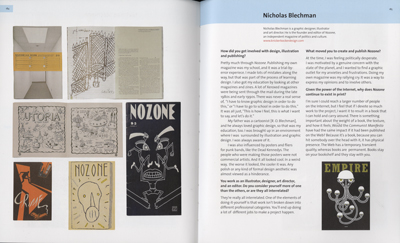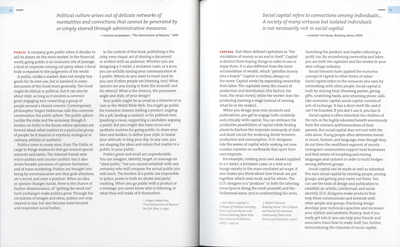The debate about the democratization of design has been circulating for a long while; long enough to draw me in, get me charged, bore me, alienate me, prompt complacency, and revolve through the loop a time or two. The recent release of D.I.Y.: Design It Yourself edited by Ellen Lupton has been a catalyst for further debate.
 Since its publishing at the begining of the year, D.I.Y. has sparked discussions on the threat of, interest in, and lessons learned from the proliferation of non-professional designers and their relationship to the discipline. These conversations quickly leave the instigating book behind to pursue polemics and broader criticism. Understandably so, as it seems to have struck a collective nerve. The fact that the text has re-ignited and triggered such discussions alone is an indication of merit. The book itself, though, is also worth a look.
Since its publishing at the begining of the year, D.I.Y. has sparked discussions on the threat of, interest in, and lessons learned from the proliferation of non-professional designers and their relationship to the discipline. These conversations quickly leave the instigating book behind to pursue polemics and broader criticism. Understandably so, as it seems to have struck a collective nerve. The fact that the text has re-ignited and triggered such discussions alone is an indication of merit. The book itself, though, is also worth a look.
For a week, D.I.Y. accompanied me on daily treks, and without surprise I ran upon many colleagues and peers with enthusiastic reception to the book. Many of them came closely linked to its cover credit. No doubt an asset to the publisher since D.I.Y. is edited by their best-selling author.
To look at D.I.Y. as a project soley of Lupton’s genesis, however, is incomplete. Several other hands and minds were involved in the project, most of which are student, colleague, or family of Ellen Lupton. It is important to view D.I.Y. through this lens of collective authorship. That having been said, there are some issues indroduced by this compiled content which are well worth consideration.
A do-it-yourself guide to small-scale graphic design projects, D.I.Y. gets most of its page count from object-specific chapters ranging from T-shirts to CD packaging that highlight possible stylistic directions, common mistakes, and production techniques. Think a current BFA design portfolio and you’re likely to have a picture of what’s covered. You won’t find motion graphics or heavy type-setting. A few inclusions, take wall-graphics and embroidery, may even be a nice find for an experienced professional.
Chapters oscillate between the handful of contributors, so a certain discontinutiy arrises with a linear read. This sometimes works in other design texts, but in the case of a non-critical guide for a crafty audience, I’m not sure if this is to its benefit. The result is mildly chaotic and leaves some chapters begging to borrow a page or two of content their neighbors. When later revisiting for specifc tips, the disjointedness is less likely to be a hinderance.
Pooled authorship takes affect on subject organization.
Why are websites and blogs seperate? The website chapter manages to frame the process of planning a site, but does not really offer an approach to solving the problem. In fact, it alludes to some relatively archaic ways of executing a site. If someone picks the book up from among the man at Urban Outfitters, you can bet their perception of the line between blog and website is much less surgical than D.I.Y’s structure suggests. We all recognize the integration of blog-like organization into most emerging sites of at least nominal success. At the same time, it lacks the cost/time comparisons so thoughtfully included in the wall graphics or business card chapters.
In this chapter on business card design, we find some of the fuel for some complaints about how D.I.Y. may, in some small ways, be detrimental to professional designers. We see a spread with thirteen possible business card designs, all quite different, for a single “client.” The text excuses itself at a few points, insisting that design decisions be made only in service of the communication goals, yet I’m certain these thirteen examples are not conceived with such consideration. Though the text may say otherwise, what we find here is arbitrary stylization.

In relation to the larger debate, this one case when the brevity of the do-it-yourself guidebook approach may actually mislead and discredit the role of a professional designer. Is it cataclysmic? Of course not, but it remains frustrating. When this text is likely to have an audience already warm to design as a subject worth understanding, the opportunity to connect form and content by example is missed.
Preceding the various project guides, Ellen and Julia Lupton author the “Why D.I.Y.?” and “D.I.Y. Theory” chapters, respectively. Lupton introduces the book as non-academic and “celebrates graphic design as a medium of public communication that should be accessible to everyone.” I don’t see any inherent harm in this perspective, and with such intent framing the content, it is difficult to argue that what follows is anything other than a sincere attempt to do just that.
The scattered nature of the book first reveals itself when Julia Lupton’s chapter follows with references to Karl Marx and weavings of financial and social capital into the value of the do-it-yourself movement. At one point d.i.y. is a tool with which the public can sidestep the choices offered to them by corporations and thirty pages later it is pointed out that the craftsy approach of drawing on the surface of CD-Rs can save your garage band some money. It is not that these things are in contradiction, but to parallel them in what amounts to a how-to book is disorienting.
Concluding the book are a handful of interviews with professional designers that got a d.i.y. start. Here, the you-too-can-become-a-professional ideas which critics point to are punctuated with encouraging examples.

What makes D.I.Y. of value to trained designers and seasoned professionals?
› Most notable is attention to design detail of the book itself. It’s worth a good study and use-test by any concerned practitioner with an appreciation of nuances.
› An icon system is used to represent cost and time investment. It cleverly avoids specificity yet retains its value as a tool for comparison.
› D.I.Y.’s page composition is akin to Thinking With Type, both refined and inviting. Sentences rarely fall across columns and never break onto the following page. We can truly appreciate the role of the designer/author’s sensitivity to the flow of text.

So what is it that D.I.Y. (the book) says d.i.y. (the sentiment) offers: subversion, frugality, creative expression, crafty satisfaction and a touch of pre-professional encouragement. Of course, it says this while floating uncertainly between each. Perhaps this lack of grounding is one way to reflect the current state of the design discipline. I’d be hard-pressed to make much of a case otherwise, but I do wish something in the book was more conclusive. There’s one thing I know for sure, the embroidered Zig Zag shirts are svelt.
Randy J. Hunt is an MFA Design candidate at SVA, founder of Citizen Scholar, and Minister of Relevance at schwadesign, Inc..
![]()
D.I.Y.: Design It Yourself edited by Ellen Lupton
Paperback: 176 pages
Publisher: Princeton Architectural Press (January 1, 2006)
ISBN: 1568985525






Thanks for this review, Randy. You call our attention to a lot of issues that haven't been touched on elsewhere. Furthermore, your use of the word crafty falls in line with my theory that DIY is the Arts & Crafts of the 21st Century. This is not a rebellion against design, but perhaps a quicker path for generating ideas, where DIY forgoes technologies and even the service bureaus we rely on for production. Like Morris, DIY places the power and responsibility of production in the hands of the craftsmen-artists-designers. So doesn't this restore pride in the work they do?
On Mar.07.2006 at 09:45 AM